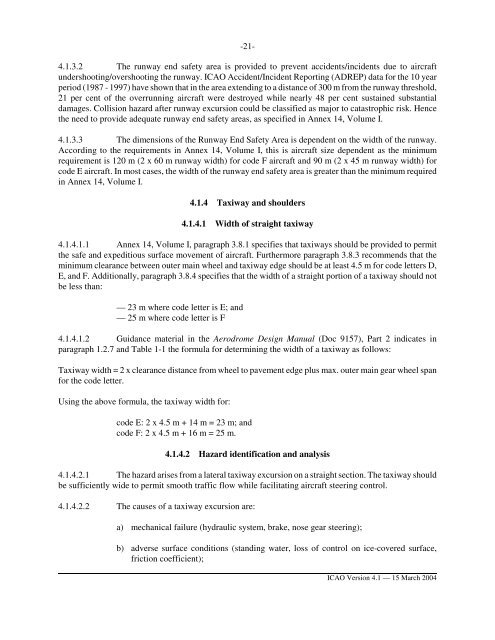Draft ICAO Circular on NLA.pdf - Airports Council International
Draft ICAO Circular on NLA.pdf - Airports Council International
Draft ICAO Circular on NLA.pdf - Airports Council International
Create successful ePaper yourself
Turn your PDF publications into a flip-book with our unique Google optimized e-Paper software.
-21-<br />
4.1.3.2 The runway end safety area is provided to prevent accidents/incidents due to aircraft<br />
undershooting/overshooting the runway. <str<strong>on</strong>g>ICAO</str<strong>on</strong>g> Accident/Incident Reporting (ADREP) data for the 10 year<br />
period (1987 - 1997) have shown that in the area extending to a distance of 300 m from the runway threshold,<br />
21 per cent of the overrunning aircraft were destroyed while nearly 48 per cent sustained substantial<br />
damages. Collisi<strong>on</strong> hazard after runway excursi<strong>on</strong> could be classified as major to catastrophic risk. Hence<br />
the need to provide adequate runway end safety areas, as specified in Annex 14, Volume I.<br />
4.1.3.3 The dimensi<strong>on</strong>s of the Runway End Safety Area is dependent <strong>on</strong> the width of the runway.<br />
According to the requirements in Annex 14, Volume I, this is aircraft size dependent as the minimum<br />
requirement is 120 m (2 x 60 m runway width) for code F aircraft and 90 m (2 x 45 m runway width) for<br />
code E aircraft. In most cases, the width of the runway end safety area is greater than the minimum required<br />
in Annex 14, Volume I.<br />
4.1.4 Taxiway and shoulders<br />
4.1.4.1 Width of straight taxiway<br />
4.1.4.1.1 Annex 14, Volume I, paragraph 3.8.1 specifies that taxiways should be provided to permit<br />
the safe and expeditious surface movement of aircraft. Furthermore paragraph 3.8.3 recommends that the<br />
minimum clearance between outer main wheel and taxiway edge should be at least 4.5 m for code letters D,<br />
E, and F. Additi<strong>on</strong>ally, paragraph 3.8.4 specifies that the width of a straight porti<strong>on</strong> of a taxiway should not<br />
be less than:<br />
— 23 m where code letter is E; and<br />
— 25 m where code letter is F<br />
4.1.4.1.2 Guidance material in the Aerodrome Design Manual (Doc 9157), Part 2 indicates in<br />
paragraph 1.2.7 and Table 1-1 the formula for determining the width of a taxiway as follows:<br />
Taxiway width = 2 x clearance distance from wheel to pavement edge plus max. outer main gear wheel span<br />
for the code letter.<br />
Using the above formula, the taxiway width for:<br />
code E: 2 x 4.5 m + 14 m = 23 m; and<br />
code F: 2 x 4.5 m + 16 m = 25 m.<br />
4.1.4.2 Hazard identificati<strong>on</strong> and analysis<br />
4.1.4.2.1 The hazard arises from a lateral taxiway excursi<strong>on</strong> <strong>on</strong> a straight secti<strong>on</strong>. The taxiway should<br />
be sufficiently wide to permit smooth traffic flow while facilitating aircraft steering c<strong>on</strong>trol.<br />
4.1.4.2.2 The causes of a taxiway excursi<strong>on</strong> are:<br />
a) mechanical failure (hydraulic system, brake, nose gear steering);<br />
b) adverse surface c<strong>on</strong>diti<strong>on</strong>s (standing water, loss of c<strong>on</strong>trol <strong>on</strong> ice-covered surface,<br />
fricti<strong>on</strong> coefficient);<br />
<str<strong>on</strong>g>ICAO</str<strong>on</strong>g> Versi<strong>on</strong> 4.1 — 15 March 2004

















